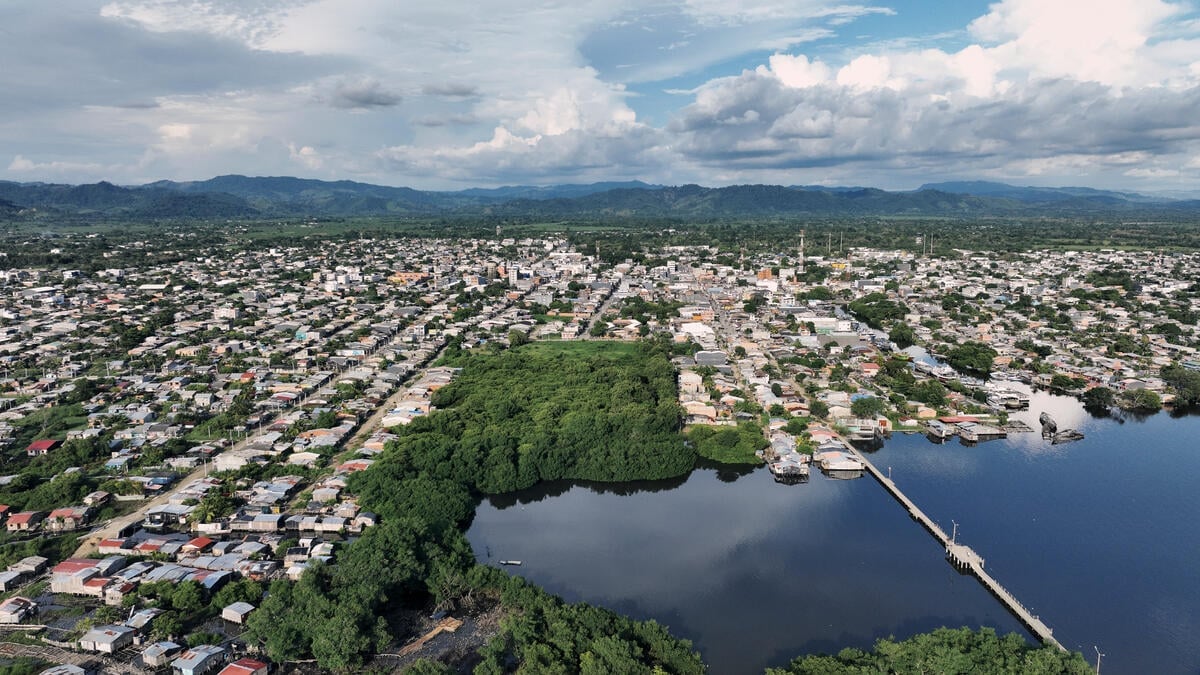Mangrove conservation brings brighter future to fishing community in Colombia
Mangrove conservation brings brighter future to fishing community in Colombia

An aerial view of Turbo in northern Colombia and what remains of the surrounding mangrove forest.
In the neighbourhoods of Pescador 1 and 2, in Turbo, northern Colombia, mangroves intertwine to create a natural barrier between land and sea that protects against soil erosion and storm surges. Over the years, however, much of this unique coastal forest, and the vital habitat it provides, has been lost to deforestation, pollution, and the pressure of a growing population.
The residents of this area are mainly fishermen and internally displaced people who fled their homes due to Colombia’s decades-long armed conflict. For many of them, environmental degradation means not only losing the region’s biodiversity, but their livelihoods.
Secarlos Martínez, a local fisherman, has witnessed the loss of the mangroves and the fish that used to spawn in them. “When we were young, for as long as I can remember, the mangroves took up 90 per cent of the neighborhood. The population growth is gradually killing the mangroves. Eighty percent have been cleared for residential use,” he said.
He added that the situation has been compounded by the impacts of climate change on the Gulf of Urabá, the long, wide inlet where Turbo is located. “The fish have fled, and that has led to economic hardship for us,” he said.

Secarlos Martinez (left) fishes in Turbo Bay. The loss of the mangroves has impacted his livelihood.
Guardians of the mangroves
In the face of these challenges, a group of Turbo residents, including displaced people, community leaders and fishermen like Secarlos, has come together to restore the mangroves. They formed the Guardianes del Mangle (“Mangrove Guardians”) in 2017 and seven years later the group is supported by the UN Refugee Agency’s Environment and Climate Action Innovation Fund. In addition to bringing the mangroves back to life, the initiative aims to strengthen the community and explore new livelihood opportunities for its residents.
Group member Eneida María Valencia, 59, was forcibly displaced from her home in Riosucio, Chocó in 1997. She had to flee, together with her family and many other people from her community, after receiving an ultimatum from an armed group demanding that they leave the town within a couple of days. “We had to leave everything behind - our belongings, our livelihoods – and have no other option but to beg, which is something we did not have to do over there,” she said.
She and the rest of the group carry out clean-ups to remove solid waste from the mangroves, grow and plant seedlings for reforesting, and raise awareness about the importance of mangroves in protecting the community from environmental hazards.
“The mangroves’ most beautiful trait is that they protect us from flooding and storms,” said Diana Colón, chair of Pescador’s Community Action Board.
In 2018, inspired by Secarlos, she joined the Mangrove Guardians initiative to protect the local ecosystem she cherishes. Diana remembers playing among the mangroves as a child and recognizes their importance for her community’s well-being. Today, she leads awareness and clean-up activities, as well as the “Semillero de Arte”, an art workshop for children and adults.
Besides preserving the mangroves, she said the project had revitalized community life. “These neighbourhoods (Pescador 1 and 2) used to be rivals, but now we’re working shoulder to shoulder. We’ve become friends. We’re closer together now.”
A new purpose
On the days when the mangroves close to Eneida’s home are to be cleaned, both children and adults put on their gloves and gather to take part. Together, they remove solid waste from the mangrove areas, which helps improve water flow, reduce pollution, and create a healthier ecosystem.
A seedling bank has been created to plant new trees down the road, supporting not only local restoration efforts but also offering a resource for other reforestation projects.
The community’s efforts are starting to bring flora and fauna back to the area. “We’ve proven that wildlife can come back,” said Secarlos, who is chair of the group. “Lately, we’ve seen ducks, herons, and other animals that had vanished.”
He added that restoring the mangroves has also brought economic benefits in the form of new livelihoods. “People were not used to recycling, but we have started to collect waste door-to-door. Some people now live off recycling.”
For Eneida, the project has brought hope and allowed her to repay the community that has hosted her: “This project has given me a purpose,” she asserted. “I no longer wish to go back to the place I was displaced from. I’m currently helping my community and the mangroves. That way, my children will have a brighter future.”













